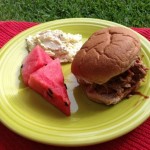
Keep hot foods hot and cold foods cold to reduce the risk of foodborne illness, especially in hot weather.
It’s time for all the fun things that summer brings, like picnics, potlucks, and outdoor gatherings. These are ways we all enjoy celebrating the summer sunshine with friends and family. As things heat up outside, don’t forget the basic rules of food safety to protect yourself and others from foodborne illness.
When transporting, preparing, and serving food outdoors, there are many critical things to consider. First, keep your hands clean. If soap and running water are not available, be prepared with disposable antibacterial wet wipes and hand sanitizer. Use it often and keep it available for everyone at your event.
Be sure to use an insulated cooler with plenty of frozen gel packs and ice for all foods that require refrigeration. Perishable foods, such as potato salads, burgers, hot dogs, chicken, and cheese, should be stored at 40 degrees or less to prevent the growth of harmful bacteria. Pack your cooler accordingly to prevent cross-contamination, securely wrapping and separating raw and ready-to-eat foods, putting raw foods on the bottom. Consider using a separate cooler for juice boxes, soda cans, and water bottles. This will help protect food items from the heat when guests are frequently opening and closing the cooler for drinks.
Cold foods should be kept in the cooler as long as possible before being taken out to serve. Once outside of the cooler, these foods should not set out any longer than 2 hours. If it is really warm (over 90 degrees), one hour should be the limit. Foods that are in the Danger Zone, which is in the range of 40-140 degrees F, for more than this length of time, will start to grow dangerous levels of bacteria. It’s a good idea to serve foods such as potato salad, cut fruit and vegetables, as well as dips and cheeses, in shallow dishes directly in contact with ice. This will help suppress the bacterial growth while it is out of the cooler.
Grilled meats and other hot foods should be kept at a minimum of 140 degrees until served. If prepared prior to the outdoor gathering, wrap foods in foil to retain heat and use a separate insulated cooler just for hot foods. These foods also should not sit out for more than one to two hours. Consider using Sterno cans to keep food hot in covered aluminum pans or chafing dishes. Always use a food thermometer to be sure meats are cooked to the proper minimum temperature (160 degrees F for burgers and 165 degrees F for chicken) before storing or serving. For additional information, check out www.fda.gov or www.foodsafety.gov.
- Nutrition and Memory - August 1, 2025
- Exercise Boosts Brain Power - July 1, 2025
- Chronic Inflammation and Dietary Habits - April 2, 2025
